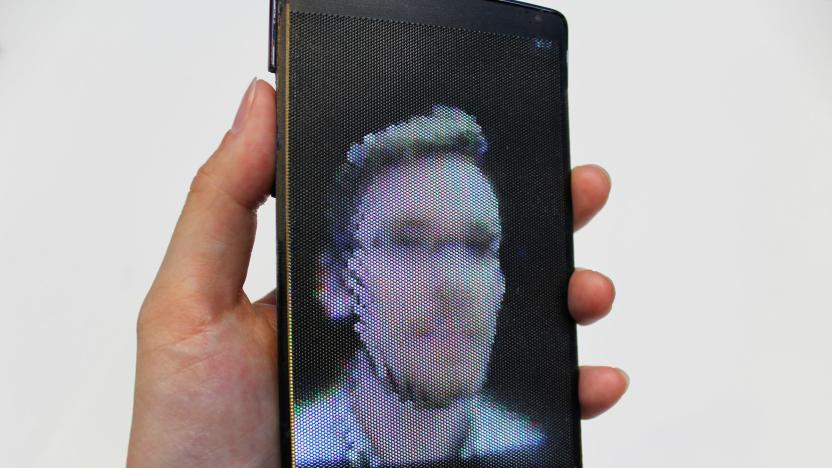HumanMediaLab
Latest

The HoloFlex is a flexible, glasses-free 3D display
Researchers at the Queen's University Human Media Lab in Ontario have developed what they claim is the "world's first holographic flexible smartphone" display. Dubbed the HoloFlex, the display uses an array of tiny lenses overlaid onto one flexible 1,920 x 1,080 HD OLED screen and allows multiple people to simultaneously view 3D images without the need for clunky glasses, complex projectors or individual head tracking.

ICYMI: Feedback flex screen, cyborg Olympics and more
#fivemin-widget-blogsmith-image-580621{display:none;} .cke_show_borders #fivemin-widget-blogsmith-image-580621, #postcontentcontainer #fivemin-widget-blogsmith-image-580621{width:570px;display:block;} try{document.getElementById("fivemin-widget-blogsmith-image-580621").style.display="none";}catch(e){}Today on In Case You Missed It: Researchers built a prototype flexible display smart device with tactile feedback to actually use the bendable display for control within apps. Actev Motors has a new $600 go-cart for kids that has smart sensors that keeps it from crashing into things, and a parental control app that sets miles per hour limits. And to a person, we are so excited for the upcoming Zurich Cybathalon event next fall. In it, people with physical handicaps can compete in Olympic-like events designed for electric wheelchairs, exoskeleton suits and the like. We are also tickled by this video of a Star Wars droid translation helmet, so hopefully you enjoy it as well. As always, please share any interesting science or tech videos, anytime! Just tweet us with the #ICYMI hashtag to @mskerryd.

ICYMI: Record-setting bot walk, holographic drones and more
#fivemin-widget-blogsmith-image-309632{display:none;} .cke_show_borders #fivemin-widget-blogsmith-image-309632, #postcontentcontainer #fivemin-widget-blogsmith-image-309632{width:570px;display:block;} try{document.getElementById("fivemin-widget-blogsmith-image-309632").style.display="none";}catch(e){}Today on In Case You Missed It: Researchers from Queens University built tiny quadcopters that can join to form a hologram display, hovering in mid-air. A Guinness World Record for furthest distance by a quadruped robot was set in China by a quirky cute robot we'd love to see more of. And we're into this Kickstarter project for a device that would turn any watch into a smartwatch with vibration for notifications, a heart rate monitor and control for music and photos.

'TeleHuman' uses Kinect for 3D holographic chat, bumps up options for contacting Obi-Wan (video)
Looks like virtual Tupac might have some company. With Kinect, you are the hologram. Besides logging in lots of quality time at a South Korean theme park, the Kinect is now doing double duty at the Human Media Lab of Queen's University in Canada thanks to a 3D holographic chat system called "TeleHuman." The setup basically creates a life-size rendering of its subject by using six Kinect sensors, a 3D projector and a cylindrical display. This allows the viewer to walk around the cylinder for a 360-degree view of the subject, giving new meaning to having someone's back during a chat. The director of the Human Media Lab says the TeleHuman could be available for $5,000 within five years. In the meantime, the tech is also being used by the research team to create a 3D anatomical model browser called the "BodiPod." The BodiPod can display various layers of the human body, which can be virtually peeled off as the viewer gets closer to the display. Check out all the 3D action for the TeleHuman and BodiPod in plain, old 2D by viewing the video after the break.

Hexagonal interactive OLED gaming tiles likely to cost a bundle, would sure spice up our Wednesday nights
We've seen plenty of ways for board games to be revitalized with large touchscreens, but a new concept from the Human Media Lab at Queen's University in Ontario puts the screens and interactivity onto the gaming pieces themselves. The idea would be to use slim, networked touchscreen hexagonal tiles with edge-to-edge OLED displays. The proximity of the tiles to one another, along with gestures performed with the tiles, provides the interactivity, and the occasional branching touchscreen menu selection keeps play humming. Unfortunately, that enabling tech isn't all there yet (at least in university-affordable forms), but the video demo after the break is pretty convincing in its presentation of these ideas in a top-down-projection simulation. Certainly promising, but we're sure not expecting to see this sort of gaming priced within reach of your average Sorry! board anytime soon.


